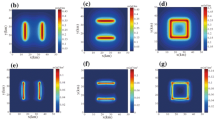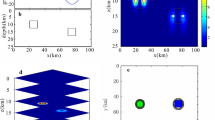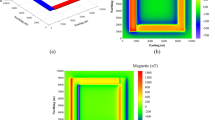Abstract
Edge detection of magnetized structures is an important application of magnetic filters for geological interpretations. In this way, one can mention methods of the potential field derivatives which are categorized into: methods based on scalar potential field and potential field gradient tensor (PGT) data. Using five independent signal components, methods based on the PGT matrices have higher accuracy than methods based on scalar potential field data. Investigations of various methods of edge detection show that as geologic conditions become more complex, they greatly lose their efficacy and sometimes suffer from distortions. These distortions probably result from the Gibbs phenomenon which occurs in the process of computing the potential field data derivatives. This phenomenon creates false edges and incorrect interpretations of data. The thetaPGT method addresses this phenomenon by combining the PGT matrix and the previously derived theta map method. The maximum value of thetaPGT delineates the horizontal edge of geologic contacts. Achieved results by applying the thetaPGT method on simple and then complex synthetic magnetic models demonstrates higher accuracy of the proposed method in comparison with the analytic signal, theta and horizontal directional theta (HDT) methods. The new method has no sensitivity to depth and strike, and also doesn’t create additional edges. Furthermore, it has lower noise sensitivity and significantly reduces the effect of the Gibbs phenomenon. Finally, applying this method on real magnetic data from the Varzeghan area, northwest Iran, with respect to other methods reveals more details of structures in the area and characterized false faults resulting from the Gibbs phenomenon.













Similar content being viewed by others
References
Ansari, A., & Alamdar, K. (2011). A new edge detection method based on the analytic signal of tilt angle (ASTA) for magnetic and gravity anomalies. Iranian Journal of Science and Technology (Sciences),35(2), 81–88.
Beiki, M. (2010). Analytic signals of gravity gradient tensor and their application to estimate source location. Geophysics,75(6), I59–I74.
Cooper, G. R. J. (2009). Balancing images of potential-field data. Geophysics,74(3), L17–L20.
Cooper, G. R. J., & Cowan, D. (2006). Enhancing potential field data using filters based on the local phase. Computers & Geosciences,32(10), 1585–1591.
Cooper, G. R. J., & Cowan, D. R. (2008). Edge enhancement of potential-field data using normalized statistics. Geophysics,73(3), H1–H4.
Cordell, L., & Grauch, V. (1985). Mapping basement magnetization zones from aeromagnetic data in the San Juan basin, New Mexico. In W. J. Hinze (Ed.), The utility of regional gravity and magnetic anomaly society of exploration geophysics (pp. 181–197). Tulsa, Oklahoma, United States: Society of Exploration Geophysicists.
Corrêa, G. J. P. (2001). Fourier derivatives and Hilbert transforms: The odd and the eccentric. In SEG International Exposition and Annual Meeting, San Antonio, Texas, September 9–14, 2001.
Ganiyu, S., Badmus, B., Awoyemi, M., Akinyemi, O., & Olurin, O. T. (2012). Upward continuation and reduction to pole process on aeromagnetic data of Ibadan Area, South-Western Nigeria. Earth Science Research,2(1), 66.
Hansen, R., & DeRidder, E. (2006). Linear feature analysis for aeromagnetic data. Geophysics,71(6), L61–L67.
Li, L., Huang, D., Han, L., & Ma, G. (2014). Optimised edge detection filters in the interpretation of potential field data. Exploration Geophysics,45(3), 171–176.
Ma, G. (2013). Edge detection of potential field data using improved local phase filter. Exploration Geophysics,44(1), 36–41.
Ma, G., Liu, C., & Huang, D. (2015). The removal of additional edges in the edge detection of potential field data. Journal of Applied Geophysics,114, 168–173.
Mehrpartou, M. (1997). Geological map of Siahrood (1:100000). Geological Survey & Mineral Explorations of Iran.
Mickus, K. L., & Hinojosa, J. H. (2001). The complete gravity gradient tensor derived from the vertical component of gravity: A Fourier transform technique. Journal of Applied Geophysics,46(3), 159–174.
Mikhailov, V., Pajot, G., Diament, M., & Price, A. (2007). Tensor deconvolution: A method to locate equivalent sources from full tensor gravity data. Geophysics,72(5), I61–I69.
Miller, H. G., & Singh, V. (1994). Potential field tilt—a new concept for location of potential field sources. Journal of Applied Geophysics,32(2–3), 213–217.
Nabighian, M. N. (1972). The analytic signal of two-dimensional magnetic bodies with polygonal cross-section: Its properties and use for automated anomaly interpretation. Geophysics,37(3), 507–517.
Nabighian, M. N. (1984). Toward a three-dimensional automatic interpretation of potential field data via generalized Hilbert transforms: Fundamental relations. Geophysics,49(6), 780–786.
Opletal, M., Baburek, J., & Ambrozek, V. (2011). Geological map of Eshtobin (1:25000). Geological Survey & Mineral Explorations of Iran.
Oruç, B., & Keskinsezer, A. (2008). Structural setting of the northeastern Biga Peninsula (Turkey) from tilt derivatives of gravity gradient tensors and magnitude of horizontal gravity components. Pure and Applied Geophysics,165(9–10), 1913–1927.
Oruç, B., Sertçelik, I., Kafadar, Ö., & Selim, H. (2013). Structural interpretation of the Erzurum Basin, eastern Turkey, using curvature gravity gradient tensor and gravity inversion of basement relief. Journal of Applied Geophysics,88, 105–113.
Pedersen, L., & Rasmussen, T. (1990). The gradient tensor of potential field anomalies: Some implications on data collection and data processing of maps. Geophysics,55(12), 1558–1566.
Phillips, J. D., Hansen, R. O., & Blakely, R. J. (2007). The use of curvature in potential-field interpretation. Exploration Geophysics,38(2), 111–119.
Roest, W. R., Verhoef, J., & Pilkington, M. (1992). Magnetic interpretation using the 3-D analytic signal. Geophysics,57(1), 116–125.
Sertcelik, I., & Kafadar, O. (2012). Application of edge detection to potential field data using eigenvalue analysis of structure tensor. Journal of Applied Geophysics,84, 86–94.
Wang, J., Meng, X., & Li, F. (2015). Improved curvature gravity gradient tensor with principal component analysis and its application in edge detection of gravity data. Journal of Applied Geophysics,118, 106–114.
Wijns, C., Perez, C., & Kowalczyk, P. (2005). Theta map: Edge detection in magnetic data. Geophysics,70(4), L39–L43.
Yuan, Y., Gao, J.-Y., & Chen, L.-N. (2016). Advantages of horizontal directional Theta method to detect the edges of full tensor gravity gradient data. Journal of Applied Geophysics,130, 53–61.
Yuan, Y., & Geng, M. (2014). Directional total horizontal derivatives of gravity gradient tensor and their application to delineate the edges. In 76th EAGE conference and exhibition, Amsterdam RAI, The Netherlands, 16–19 June 2014. https://doi.org/10.3997/2214-4609.20140956.
Yuan, Y., Huang, D., Yu, Q., & Lu, P. (2014). Edge detection of potential field data with improved structure tensor methods. Journal of Applied Geophysics,108, 35–42.
Yuan, Y., & Yu, Q. (2015). Edge detection in potential-field gradient tensor data by use of improved horizontal analytical signal methods. Pure and Applied Geophysics,172(2), 461–472.
Zhou, W., Du, X., & Li, J. (2013). The limitation of curvature gravity gradient tensor for edge detection and a method for overcoming it. Journal of Applied Geophysics,98, 237–242.
Zuo, B., & Hu, X. (2015). Edge detection of gravity field using eigenvalue analysis of gravity gradient tensor. Journal of Applied Geophysics,114, 263–270.
Author information
Authors and Affiliations
Corresponding author
Additional information
Publisher's Note
Springer Nature remains neutral with regard to jurisdictional claims in published maps and institutional affiliations.
Rights and permissions
About this article
Cite this article
Zareie, V., Moghadam, R.H. The Application of Theta Method to Potential Field Gradient Tensor Data for Edge Detection of Complex Geological Structures. Pure Appl. Geophys. 176, 4983–5001 (2019). https://doi.org/10.1007/s00024-019-02226-z
Received:
Revised:
Accepted:
Published:
Issue Date:
DOI: https://doi.org/10.1007/s00024-019-02226-z




